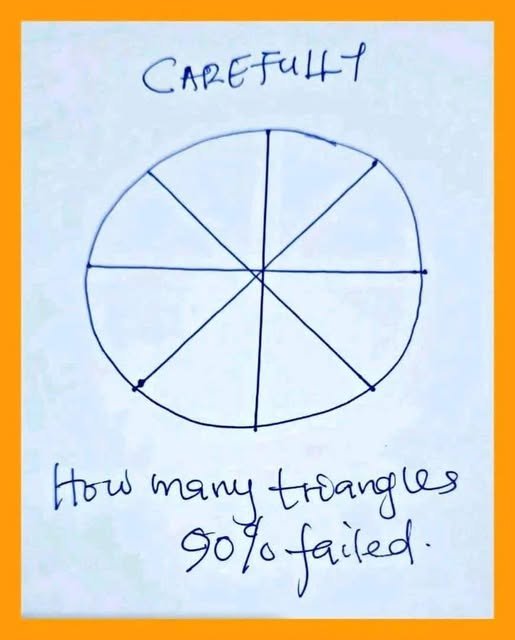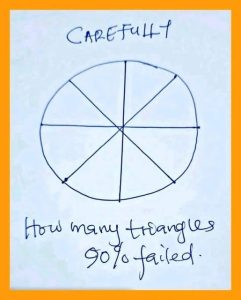
Puzzles and brain teasers are designed not only to entertain but to challenge the way we perceive and analyze visual information. One deceptively simple riddle circulating online asks: “How many triangles are in the circle?” It comes with a hand-drawn circle divided into 8 equal parts—like slices of a pie. Despite its apparent simplicity, 90% of people reportedly answer incorrectly. So, what causes this widespread error? Let’s explore the psychology, perception traps, and cognitive biases behind this viral puzzle.
The Setup: A Simple Circle Divided Into 8 Sections

At first glance, the puzzle shows a circle with lines drawn from the center to the edge, dividing the circle into 8 equal parts. The image typically includes a handwritten note saying:
“Carefully: How many triangles? 90% failed.”
The lines radiate from a central point, forming 8 distinct, pie-like segments. Each segment is, geometrically speaking, a triangle—with two radii and the arc connecting their outer ends forming the sides.
Yet many people hesitate, overthink, or completely miscalculate the number of triangles. But why?
Common Wrong Answers — And Why They Happen
Here are some of the most common incorrect answers and the reasons behind them:
1. Answering “0” — The Overthinker’s Trap
Some people respond with “0” triangles, believing that since the outer edge is curved (not a straight side), these shapes do not qualify as “real” triangles. This reveals a deeper misunderstanding of conceptual versus geometric definitions. A sector in a circle is often simplified as a triangle in basic puzzles, especially when the focus is on countability rather than strict geometry.
2. Answering “4” or “6” — The Pattern Misread
Others count fewer sections, possibly misjudging the actual number of divisions. This error is often due to quick glancing rather than careful inspection. Visual fatigue or symmetry illusions can make people “group” sections without counting precisely.
3. Answering “16” or More — The Hidden Shapes Illusion
Some overanalyze and start looking for overlapping or hidden triangles. They assume it’s like those puzzles where smaller triangles combine to form larger ones. But in this case, there are no intersecting lines except at the center. Each slice is independent.
The Correct Answer: 8 Triangles

When we look closely at the circle, it’s clear that the lines form 8 separate triangular shapes, radiating from the center. Each “slice” of the pie is a triangle because:
-
It has two straight lines (radii) meeting at the center.
-
The arc (while curved) connects the ends, forming a closed shape.
-
For simplicity in such puzzles, curved sides are treated as valid.
So, the correct and most reasonable answer is 8.
The Real Trick: Psychological Misdirection
So why do so many people fail? The puzzle’s clever use of psychological cues plays a huge role.
1. Priming With “Carefully” and “90% Failed”
Words like “carefully” and “90% failed” create a sense of urgency and doubt, encouraging you to think there’s a hidden trick. This primes the brain to overcomplicate the solution, even when the answer is straightforward.
2. Fear of Obvious Answers
Most people are afraid to trust their intuition when told others have failed. This is called the social proof trap—we assume that if most people get it wrong, our first instinct must be wrong too. So we second-guess ourselves.
3. Cognitive Load and Visual Confusion
Many viewers briefly glance and try to make quick judgments. But when the brain processes geometric shapes under time pressure, shortcuts (heuristics) kick in. This often leads to inaccurate estimations or false pattern recognition.
The Role of Visual Perception in Errors
Human brains are wired to recognize patterns, but sometimes we fall victim to our own visual shortcuts. Here’s how:
-
Gestalt principles (like symmetry and proximity) make us see the image as a unified circle rather than separate triangles.
-
Peripheral blindness causes people to overlook certain lines unless they consciously count.
-
Center-based grouping may lead people to view the circle as a starburst rather than individual slices.
Why Simple Puzzles Are So Effective at Fooling Us
This puzzle is a great example of how simple visuals combined with clever phrasing can completely throw off human reasoning. We often assume:
-
There must be a trick.
-
The answer can’t be that obvious.
-
We should find something hidden.
In truth, our overthinking is what betrays us—not the complexity of the problem.
What Can We Learn from This?
-
Trust Basic Logic: Sometimes the simplest answer is correct.
-
Count Methodically: Don’t rely on visual intuition alone—use systematic counting.
-
Be Aware of Priming: Emotional cues like “most people failed” are meant to distract you.
-
Know When to Stop: Not every problem has a deeper level. Learn to stop when you reach a logical conclusion.
Final Thoughts
The “How many triangles?” puzzle is more than just a fun riddle—it’s a mirror into how our brains work under subtle pressure. While the actual answer is just “8,” the way people interpret the question varies widely due to cognitive biases, psychological priming, and visual perception errors.
In the end, puzzles like this remind us that sometimes, thinking less is actually thinking better.


